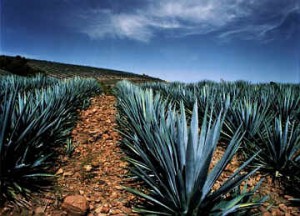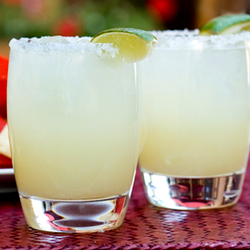
Tequila & Sangrita
Surprisingly there is still a huge Tequila divide. For people in the business of alcohol beverages Tequila is a beautiful and sometimes magical nectar. For many drinking enthusiasts the mere mention of the word will send shivers down their spines.
This has not slowed the sales and appreciation of Tequila in any way as Tequila is a category on the rise. In fact, Tequila sales have been growing at an average rate of five-and-a-half percent annually since 2002. However, there are still a lot of consumers of adult beverages who have been previously scared by cheap Tequila and are fearful of dipping their toes back in that stream.
Hopefully we can calm any remaining fears and encourage the drinks adventurists that dabble in all varieties of wine and have been known to sip a quality Gin or Whiskey from time to time to give real Tequila a chance.
What is Tequila?
Tequila is a specific, closely regulated, type of Mezcal (or Mescal). In other words, all Tequila are mescals but not all Mezcal is Tequila. Mezcal is a distilled alcohol made from any type of native agave plant in Mexico. There are hundreds of varieties of agave in Mexico and a couple dozen or more can be used to make Mezcal.

Agave – The magical source of Tequila
The base ingredient is the mysterious blue agave plant that resembles a cactus but is actually a member of the lily family. The best Tequilas are made with 100% Blue Agave. If the label doesn’t clearly state that it is “100% Agave” it’s not! Rather, it’s a simple Tequila that was commonly called “Mixto.” These simple and often cheap Tequilas must contain at least 51% blue agave, which means of course that they can contain up to 49% of other sugars that are fermented along with the agave. If you have had a bad Tequila experience, it’s most likely to have happened with a Tequila of this class.
From these two classes of Tequilas there are five categories of Tequila that are primarily defined by aging.
The Tequila Classes:
- Blanco or Plata – Pure, unaged Tequila
- Joven or Oro – aka Gold Tequila is pale gold in color
- Reposado – aged in wood barrels for at least two months and less than 12 months
- Añejo – aged in wood barrels for a minimum of 12 months
- Extra Añejo – aged in wood barrels for a minimum of 36 months
A Brief History of Tequila
The exact beginnings of an agave-based distillate (Mezcal wine as dubbed by the Spaniards) cannot be precisely identified although we can be confident that it started in the early 1520s. The production of Mezcal wine took place much as it does today. The mature, bulbous agave piñas (the heart of the plant) were harvested, cooked over wood fires or baked in underground ovens, squeezed to extract the sweet juices, fermented quickly, and distilled in large clay pots.
By 1608 the Spanish government got in the act the way governments know best, they imposed a tax. The production of Mezcal and the collection of taxes continued happily until 1785 when Spain’s King Charles III, in his infinite wisdom, forbade the production of Mezcal hoping to cash in on the import taxes of wines and brandies from Spain. Charles III died in 1792 and with it the prohibition of Mezcal. The logic was faulty as the Mezcal tax far outweighed the import duties of expensive Spanish products (the Mexicans preferred, and could better afford Mezcal).
Official production resumed in 1795 and in the first half of the 19th century the area near Tequila witnessed the birth of numerous small family distilleries with adjoining taverns. It looked a lot like the American brewpub boom of the 1990s. It was at this time that the name “Tequila” was used to describe and identify Mezcal wine produced in and near the Town of Tequila in the state of Jalisco. Tequila is a specific, and regulated form of Mezcal, which is to say that all Tequila is Mezcal but not all Mezcal is Tequila. (In 1974 the Mexican government issued a declaration protecting the name Tequila and defining its production area — primarily in the state of Jalisco – and identified Agave Tequilana Weber Blue Agave – or simply Blue Agave – as the only permitted agave variety.)
Beyond history there is a lot of fascinating agave and Mezcal mythology. To read more on Tequila Myths and Legends click here.
Enjoying Tequila

Tequila in the classic Margarita
Tequila drinking culture varies greatly north and south of the Rio Grande and frequently Americans get it wrong. Tequila is appreciated and savored in Mexico often enjoyed slowly with a great supporting cast of accompaniments. Perhaps my favorite Tequila companion is sangrita (don’t read Sangria, the wine, brandy, and fruit punch of Spain). Sangrita (get our sangrita recipe) is a mix of orange and tomato juices with a dose of pepper and other spices. It is served in its own caballito (a 2 to 3 oz. glass about four inches tall) alongside a caballito of Tequila. The two are alternatively sipped until the desired level of happiness is achieved.
The pleasures of sangrita not withstanding, the Margarita is still the top application in America while in Mexico the Paloma is the number one cocktail. The Margarita does offer the perfect balance of blue agave goodness married with fresh-fruity lime juice and orange liqueur. Of course there are numerous Tequila based cocktails and we encourage you to enjoy them all.
When sipping Tequila many consumers reflexively reach for the darker añejo and extra-añejo varieties. Many dedicated Tequila fans will opt for blanco Tequila to satisfy both sipping and cocktail requirements. Blanca Tequila is the pure expression of Tequila offering all of the delicate nuances provided by the agave. Blanco fans, like myself, do enjoy a good reposado or añejo but often feel that the spirit can become dominated by the wood cask masking the subtle and unique agave flavors. Luckily there are a wide range of styles so you can choose the flavor profile that best satisfies your individual tastes.
